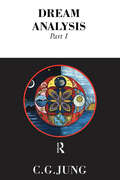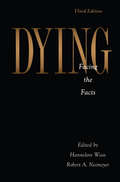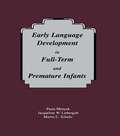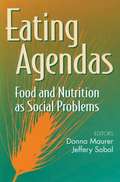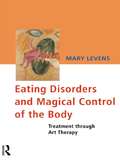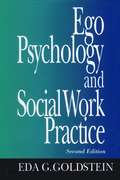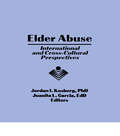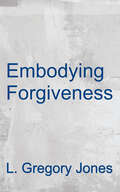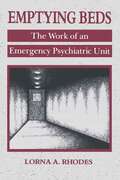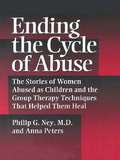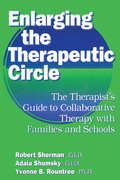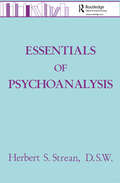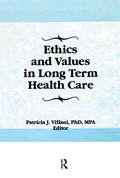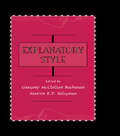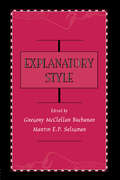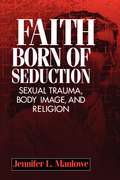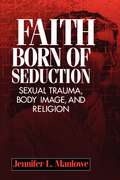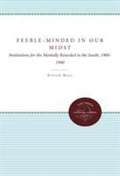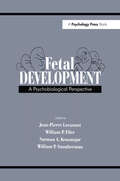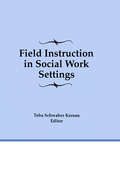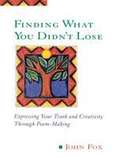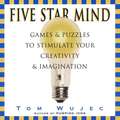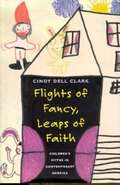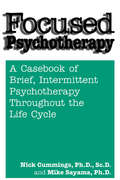- Table View
- List View
Dream Analysis 1: Notes of the Seminar Given in 1928-30 (Jung Seminars Ser. #506)
by C.G. JungProvides clarification of Jung's method of dream analysis. Based upon a previously unpublished series of dreams of one of Jung's patients.
Dying: Facing the Facts (Series in Death, Dying, and Bereavement)
by Hannelore Wass and Robert A. NeimeyerThis work provides an up-to-date examination of the ways people face dying and bereavement. In this third edition previous chapters are throrughly revised, and new contributors expand areas that have changed significantly. Reflecting the field's complex interdisciplinary character, the chapters cover such diverse areas as psychology, nursing, medicine, AIDS, family studies, sociology, education, philosophy, law, religion, the humanities and political science, whilst highlighting thanatology's core psychological and therapeutic caregiving dimensions. First, the text offers broad examinations of death systems from the vantage points of various cultural, historical and disciplinary perspectives. The second section represents the core of the book, offering detailed surveys of the "data" of death, dying and bereavement as they relate to different phases of our encounter with death as an abstract possibility and concrete reality. Next are chapters addressing a cluster of death-related issues and challenges that confront us at both a societal and individual level - such as AIDS - and finally the volume closes with a few reflections on the complexity of contemporary thanatology, framing some issues and recommendations that deserve greater attention by scholars, researchers, policy makers and practitioners. Also included is a comprehensive resource bibliography on the topic. This text is intended to be of use as a resource for all those interested in reading about death studies, both professionals and students alike.
Early Language Development in Full-term and Premature infants
by Paula Menyuk Jacqueline W. Liebergott Martin C. SchultzDesigned to provide practical information to those who are concerned with the development of young children, this book has three goals. First, the authors offer details about patterns of language development over the first three years of life. Although intensive studies have been carried out by examining from one to 20 children in the age range of zero to three years, there has been no longitudinal study of a sample as large as this--53 children--nor have as many measures of language development been obtained from the same children. Examining language development from a broad perspective in this size population allows us to see what generalizations can be made about patterns of language development. This volume's second goal is to examine the impact of such factors as biology, cognition, and communication input--and the interaction of these factors--which traditionally have been held to play an important role in the course of language development. The comparative influence of each--and the interaction of all three--were examined statistically using children's scores on standard language tests at age three. The volume's third goal is to provide information to beginning investigators, early childhood educators, and clinicians that can help them in their practice. This includes information about what appear to be good early predictors of language development at three years; language assessment procedures that can be used with children below age three, how these procedures can be used, what they tell us about the language development of young children; and what warning signs should probably be attended to, and which can most likely be ignored. In addition, suggestions are made about what patterns of communicative interaction during the different periods of development seem to be most successful in terms of language development outcomes at three years, and what overall indications the study offers regarding appropriate intervention.
Eating Agendas: Food and Nutrition as Social Problems
by Donna Maurer Jeffery SobalThe international group of sociological and nutritional scientists in this volume represent the research that has been conducted on the social problematics of food and nutrition in such areas as food safety, biotechnology, food stamp programs, obesity, anorexia nervosa, and vegetarianism. The broad range of topics addressed and the case studies examined make this book suitable as a course-related text both in foodways and cultural aspects of nutrition and as a new departure in social problems courses.
Eating Disorders and Magical Control of the Body: Treatment Through Art Therapy
by Mary LevensPeople with eating disorders often make desparate attempts to exert magical control over their bodies in response to the threats they experienced in relationships. Mary Levens takes the reader into the realm of magical thinking and its effect on ideas about eating and the body through a sensitive exploration of the images patients create in art therapy, in which themes of cannibalism constantly recur. Drawing on anthropology, religion and literature as well as psychoanalysis, she discusses the significance of these images and their implications for treatment of patients with eating disorders.
Ecopsychology: Restoring the Earth, Healing the Mind
by Theodore Roszak Mary E. Gomes Allen D. Kanner"A breakthrough book. It makes crystal clear that the natural world is not just an `environment' around us, but it is us, existing inside our souls and minds."--Jerry Mander "A very exciting book of enormous interest for everyone concerned with the future of our species--environmentalists and legislators, industrialists and educators, you and me. Its message should become part of Western thought."--Jane Goodall --This text refers to the Paperback edition.
Ego Psychology and Social Work Practice (Second Edition)
by Eda G. GoldsteinWhile ego psychological theory still holds a pre-eminent position in clinical social work practice, the field has changed in many ways. This revised edition addresses these major changes, bringing the reader up to date.
Elder Abuse: International and Cross-Cultural Perspectives
by Jordan I Kosberg Juanita L GarciaHere is an informative overview of the causes and consequences of elder abuse in countries around the world. This book delves into the global problem of elder abuse and identifies similarities and differences that occur from country to country. Elder Abuse: International and Cross-Cultural Perspectives increases understanding of the problem of elder abuse, helping you recognize more easily the causes of elder abuse in your own country and find tactics to counter these causes. Strategies from around the world can help in the development of local community resources and social policies to minimize the occurrence of elder abuse and its impact on the elderly, their families, and all members of society.Elder Abuse: International and Cross-Cultural Perspectives discusses elder abuse in countries ranging from Australia to Finland, from South Africa to Hong Kong, from Ireland to Israel. It addresses the consequences of aging, dynamics of elder abuse, family care of the elderly, formal and informal mechanisms for preventing elder abuse, and methods by which to publicize possibilities of abuse. In each chapter, authors explore: the definition of elder abuse in their country the extent of the problem causes of the problem (as related to values and practices) societal attitudes regarding the existence of the problem private and public efforts to detect and prevent the problem and to intervene where it has occurredElder Abuse: International and Cross-Cultural Perspectives provides the impetus for community resources, social planning, and public resources. It is of interest to individuals who work in social work, nursing, and psychology settings and to those in social science fields of sociology, anthropology, and gerontology. The book can also serve as an enlightening reader for undergraduate and graduate/professional education.
Embodying Forgiveness: A Theological Analysis
by L. Gregory JonesA topic unjustly neglected in contemporary theology, forgiveness is often taken to be either too easy or too difficult. On the one hand is the conception of forgiveness that views it mainly as a move made for the well-being of the forgiver. On the other hand, forgiveness is sometimes made too difficult by suggestions that violence is the only effective force for responding to injustice. In this exciting and innovative book, L. Gregory Jones argues that neither of these extreme views is appropriate and shows how practices of Christian forgiveness are richer and more comprehensive than often thought. Forgiveness, says Jones, is a way of life that carries with it distinctive concepts of love, community, confession, power, repentance, justice, punishment, remembrance, and forgetfulness. In Part 1 of Embodying Forgiveness Jones first recounts Dietrich Bonhoeffer's own struggle against the temptation to make forgiveness either too easy or too difficult in his thought and, even more, in his life and death at the hands of the Nazis. Jones then considers each of these temptations, focusing on the problem of "therapeutic" forgiveness and then forgiveness's "eclipse" by violence. Part 2 shows why a trinitarian identification of God is crucial for an adequate account of forgiveness. In Part 3 Jones describes forgiveness as a craft and analyzes the difficulty of loving enemies. He deals particularly with problems of disparities in power, impenitent offenders, and the relations between forgiveness, accountability, and punishment. The book concludes with a discussion of the possibility of certain "unforgiveable" situations. Developing a strong theological perspective on forgiveness throughout, Jones draws on films and a wide variety of literature as well as on Scripture and theological texts. In so doing, he develops a rich and comprehensive exploration of what it truly means to embody Christian forgiveness.
Emptying Beds: The Work of an Emergency Psychiatric Unit
by Lorna A. RhodesThe work of inner-city emergency psychiatric units might best be described as "medicine under siege." Emptying Beds is the result of the author's two-year immersion in one such unit and its work. It is an account of the strategies developed by a staff of psychiatrists, social workers, nurses, and other mental health workers to deal with the dilemmas they face every day.
Ending The Cycle Of Abuse: The Stories Of Women Abused As Children & The Group Therapy Techniques That Helped Them Heal
by Philip G. Ney Anna PetersFirst published in 1995. Routledge is an imprint of Taylor & Francis, an informa company.
Enlarging The Therapeutic Circle: The Therapist's Guide To Collaborative Therapy With Families & School
by Robert Sherman, Ed.D. Adala Shumsky, Ed.D. Yvonne B. Roundtree, Ph.D.First published in 1995. Routledge is an imprint of Taylor & Francis, an informa company.
Essentials Of Psychoanalysis
by Herbert S. StreanFirst published in 1995. Routledge is an imprint of Taylor & Francis, an informa company.
Ethics and Values in Long Term Health Care
by Patricia VillaniHere is an overview of many of the ethical challenges facing health care practitioners today. Health providers striving for the appropriate balance between human rights and values and the objectives within their professions confront many ethical dilemmas. This helpful book explores such dilemmas from practical and philosophical perspectives and helps practitioners successfully navigate through the maze of concerns they face on a daily basis. With Ethics and Values in Long Term Health Care, readers can develop new modes of ethical thinking that will enhance their practice as they improve the quality of life of the elderly they serve. The book presents information that can be used as a catalyst for innovative thinking and a guide for positive action. Readers are encouraged to apply the lessons contained in this book to practical decisionmaking in their respective health professions. Chapters assist health practitioners and others in thinking more in-depth about the impact of their personal ethics and values on service delivery, and help them to broaden their views and enhance their decisionmaking skills. The book has a broad scope and is divided into four sections which address: Practitioner Knowledge Caregiving End of Life Choices Health Care ReformEthics and Values in Long Term Health Care helps prepare health care professionals to confront some of the major ethics and values challenges of the 1990s and beyond. This book can be used as a guide to ethical awareness, as well as a tool for teaching ethics and values or for developing programs and workshops.
Explanatory Style
by Martin E. P. Seligman Gregory McClellan BuchananThis is the first work to condense the large literature on explanatory style -- one's tendency to offer similar sorts of explanations for different events. This cognitive variable has been related to psychopathology, physical health, achievement and success. Compiled by experts in the fields of depression, anxiety, psychoneuroimmunology and motivation, this volume details our current level of understanding, outlines gaps in our knowledge, and discusses the future directions of the field. Data from a vast number of studies are presented, including results from studies not previously reported. Coverage includes sections on cross-cultural comparisons, life-span and development issues, and gender differences; and an extensive description of the measurement of explanatory style offering questionnaire and content-analysis methods for children, college populations and adults. This work is thus a valuable tool for anyone involved in research on the etiology and treatment of depression, cognitive therapy, motivation and emotion, and the link between physical and psychological well-being.
Explanatory Style
by Martin E. P. Seligman Gregory McClellan BuchananThis is the first work to condense the large literature on explanatory style -- one's tendency to offer similar sorts of explanations for different events. This cognitive variable has been related to psychopathology, physical health, achievement and success. Compiled by experts in the fields of depression, anxiety, psychoneuroimmunology and motivation, this volume details our current level of understanding, outlines gaps in our knowledge, and discusses the future directions of the field. Data from a vast number of studies are presented, including results from studies not previously reported. Coverage includes sections on cross-cultural comparisons, life-span and development issues, and gender differences; and an extensive description of the measurement of explanatory style offering questionnaire and content-analysis methods for children, college populations and adults. This work is thus a valuable tool for anyone involved in research on the etiology and treatment of depression, cognitive therapy, motivation and emotion, and the link between physical and psychological well-being.
Faith Born of Seduction: Sexual Trauma, Body Image, and Religion
by Jennifer L ManloweHow do survivors of sexual and domestic violence relate to religion and to a higher power? What are the social and religious contexts that sustain and encourage eating disorders in women? How do these issues intersect? The relationship between Christian religious discourse, incest, and eating disorders reveals an important, and so far unexamined, psychosocial phenomenon. Drawing from interviews with incest survivors whose sexual and religious backgrounds are intimately connected with their problematic relationship with food, Jennifer Manlowe here illuminates the connections between female body, weight, and appetite preoccupations.Manlowe offers social and psychological insights into the most common forms of female suffering—incest and body hatred. The volume is intended as a resource for professionals, advocates, friends of survivors, and most importantly, the survivor of incest herself as she attempts to understand the links of meaning in her mind between her incest experience and her subsequent eating disorder.
Faith Born of Seduction: Sexual Trauma, Body Image, and Religion
by Jennifer L ManloweHow do survivors of sexual and domestic violence relate to religion and to a higher power? What are the social and religious contexts that sustain and encourage eating disorders in women? How do these issues intersect? The relationship between Christian religious discourse, incest, and eating disorders reveals an important, and so far unexamined, psychosocial phenomenon. Drawing from interviews with incest survivors whose sexual and religious backgrounds are intimately connected with their problematic relationship with food, Jennifer Manlowe here illuminates the connections between female body, weight, and appetite preoccupations.Manlowe offers social and psychological insights into the most common forms of female suffering-incest and body hatred. The volume is intended as a resource for professionals, advocates, friends of survivors, and most importantly, the survivor of incest herself as she attempts to understand the links of meaning in her mind between her incest experience and her subsequent eating disorder.
Feeble-Minded In Our Midst: Institutions for the Mentally Retarded in the South, 1900-1940
by Steven NollThe problem of how to treat the mentally handicapped attracted much attention from American reformers in the first half of the twentieth century. In this book, Steven Noll traces the history and development of institutions for the 'feeble-minded' in the South between 1900 and 1940. He examines the influences of gender, race, and class in the institutionalization process and relates policies in the South to those in the North and Midwest, regions that had established similar institutions much earlier. At the center of the story is the debate between the humanitarians, who advocated institutionalization as a way of protecting and ministering to the mentally deficient, and public policy adherents, who were primarily interested in controlling and isolating perceived deviants. According to Noll, these conflicting ideologies meant that most southern institutions were founded without a clear mission or an understanding of their relationship to southern society at large. Noll creates a vivid portrait of life and work within institutions throughout the South and the impact of institutionalization on patients and their families. He also examines the composition of the population labeled feeble-minded and demonstrates a relationship between demographic variables and institutional placement, including their effect on the determination of a patient's degree of disability.
Fetal Development: A Psychobiological Perspective
by Jean-Pierre Lecanuet William P. Fifer Norman A. Krasnegor William P. SmothermanBased on the presentations given by well-known specialists at a recent multidisciplinary conference of developmental psychobiologists, obstetricians, and physiologists, this book is the first exhaustive attempt to synthesize the present scientific knowledge on fetal behavior. Utilizing a psychobiological analytic approach, it provides the reader with an overview of the perspectives, hypotheses, and experimental results from a group of basic scientists and clinicians who conduct research to elucidate the role of fetal behavior in development. Experimental and clinical as well as human and animal data are explored via comparative developmental analysis. The ontogeny of fetal spontaneous activity -- via the maturation of "behavioral states" -- and of fetal responsiveness to sensory stimulation is studied in detail. Results are provided from studies of embryonic/fetal and newborn behavior in chicks, rats, sheep, primates, and humans. Knowledge of fetal behavior is crucial to the obstetrician, neonatologist, developmental psychologist, and even the future parents, in order to follow and assess the gradual development of spontaneous responsive movements of the fetus. While assessing this important information, this text also examines the neuro-behavioral events taking place during the fetal period as an aid to understanding normal and pathological life span development.
Field Instruction in Social Work Settings
by Toba Schwaber KersonField Instruction in Social Work Settings explores the relationship between field instruction and the setting in which it occurs. The book asserts that certain aspects of social work, including laws, funding, political climate, organizational policies, and values, affect the relationship between student and field instructor and shape teaching and learning. The book explores dimensions of the student/field instructor relationship such as goals and expectations, development of professional identity, uses of the self, issues of diversity, authority, dependency, autonomy, value dilemmas, and the structure of supervision. It presents a framework for teaching field instruction and uses the framework to explore its relevance, meaning, and use in the following settings: perinatal AIDS program public child welfare child advocacy agency public school occupational health and safety project family service psychiatric hospital case management program for the elderly day center for the elderlyField Instruction in Social Work Settings is the only book available relating field instruction to the specific context in which it occurs. It recognizes the social work field’s diminished budget and increased demands and points out the critical necessity of students learning to address and manage policy and organizational issues as they develop their social work skills. This book is an aid to field instructors balancing increases in enrollment and curriculum content and decreases in placements and budgets. It integrates all of these concerns with field practice and seeks to provide a model for those working in the field as instructors and students. Field Instruction in Social Work Settings applies classroom material to social work settings and emphasizes the value of field instruction by relating it to the branches of child welfare, mental health, and health care. It allows the reader to integrate social work policy and advocacy with field work, and it provides the reader with an appreciation of how social work and field instruction can work together directly.
Finding What You Didn't Lose: Expressing Your Truth and Creativity through Poem-Making
by John FoxPoetry discovers and speaks a truth ordinary language cannot express. And the passionate message in Finding What You Didn't Lose is that we're all poets--capable of giving voice to such truth. <P><P>Poet-teacher John Fox reveals how imagery, sound, metaphor, rhythm, and other poetic elements can he us tell our inner story, heal psychological wounds, discover spiritual connection, and develop the rich creative imagination that lies within us all. <P><P>Transcending the traditional academic approach to poetry writing, Finding What You Didn't Lose deals with craft but, more importantly, guides readers to explore their deepest feelings and express their own unique insights through the incomparable language of poetry. <P><P>Through an intermingling of inventive exercises and illustrative poems--ranging from Nobel Prize winners to first-time poets--readers are inspired to add their own distinct voice to a world fellowship of poets. For those who already write poetry, and the many more who want to, this book is the key to finding what you never lose: your natural inclination to express who you are through the making of poems.
Five Star Mind: Games and Exercises to Stimulate your Creativity and Imagination
by Tom WujecUsing puzzles, tips, thought association, relaxation techniques, games of "What If," and constant questioning, Tom Wujec cajoles you into realizing your inherent power for creative thought and expression. In addition to helping you discover your innate abilities, Wujec shows you innumerable ways to apply your new ideas and creativity to work, to everyday life, or to just having fun. With Five Star Mind, you participate in the creative process, develop your inventiveness and imagination, and enhance skills that will have you cooking up five-star ideas of your own!
Flights of Fancy, Leaps of Faith: Children's Myths in Contemporary America
by Cindy Dell ClarkSanta Claus, the Easter Bunny, the Tooth Fairy-is there still a place for these legendary creatures in today's skeptical age? Is it "right" for children to believe in them? By encouraging these myths, are parents lying to children? Moreover, do these figures undermine religious faith and encourage rampant materialism in children? In Flights of Fancy, Leaps of Faith, Cindy Dell Clark went right to the believers-American children-to explore how children themselves give meaning to Santa, the Easter Bunny, and the Tooth Fairy. Through interviews and observation conducted in real-life settings from homes to shopping malls during the holidays, she asks whether believing in these figures is good or bad for children. Using their insights, she offers fresh, new interpretations about tooth loss as a rite of passage, about Christmas (including the role of the family and the Christmas tree), and about Easter customs (including the Easter egg hunt) in contemporary America. Clark challenges the notion that the figures are merely "imaginary." She demonstrates how children actively shape these traditions through their own creativity and beliefs. And because they require the child's faith in order to be experienced, they play an important and singular role in a child's psychological development. Through the mysteries and myths of Christmas and Easter, families balance the values of receiving and giving, of growth and sacrifice. Each aspect of the Santa myth, from his slide down a chimney to his big red suit, plays a part in a child's imagination. Through their offerings of milk and cookies and their letter writing, children bring their relationship to Santa into developing attitudes toward giving and receiving gifts. The Easter Bunny story, with its ritual egg hunt and baskets of brightly colored candy, is explored in terms of life and its possibility of growth. In these examples, Clark shows how children play an active role in constructing family rituals and cultural reality, since their willingness to make the stories their own helps to renew the traditions. This engaging look at our central symbols will hold great interest for parents, as well as for teachers, psychologists, and other professionals concerned with childhood culture. Complete with children's vivid testimonies and colorful illustrations, it is a revealing journey into a child's mind and world.
Focused Psychotherapy: A Casebook Of Brief Intermittent Psychotherapy Throughout The Life Cycle
by Nick Cummings Mike SayamaFocused Psychotherapy Offers practitioners an approach to psychotherapeutic treatment that is both financially viable and has sufficient clinical depth to assure genuine psychological growth. Providing a strikingly clear description of this approach, this volume enables psychotherapists to quickly hone in on the client's true agenda, therefore avoiding unnecessarily long and drawn out therapeutic work.
